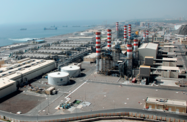Industrial activity is on the rise in Abu Dhabi as the emirate’s drive towards sustainable economic diversification under Abu Dhabi Economic Vision 2030 gathers pace. The recently opened Khalifa Industrial Zone Abu Dhabi (Kizad) is likely to be a key engine of growth for the emirate, while a recent multi-billion dollar merger between the UAE’s two aluminium manufacturers is also set to bolster plans for industrial expansion.
The manufacturing sector has performed well in recent years, with growth doubling from 11% in 2010 to 22% in 2011, according to the Abu Dhabi Department of Economic Development. Net profits for manufacturing companies listed on the Abu Dhabi Securities Exchange were up 109% year-on-year in 2012.
Kizad, which was inaugurated last September, is targeting tenants based in the manufacturing and logistics sectors. Activities at the industrial zone are expected to account for 15% of the emirate’s non-oil GDP by 2030.
The first phase of the project, which covers a 52-sq-km area, including the new deepwater Khalifa Port, has already attracted more than 50 Emirati and international firms, while the next stage will see the zone expanded to 418 sq km.
In line with Abu Dhabi’s development strategy, Kizad has been organised by clusters, each of which will be centred around a primary industry – a steel factory, for example – with further processing and manufacturing facilities located nearby.
Khaled Salmeen, CEO of Kizad, told OBG that this vertically integrated structure offers a number of benefits. “Each cluster is focused on a key primary industry, with a number of related midstream and downstream processes located close by,” he said. “Other suppliers and service companies serving each stage of the value chain will also be encouraged to establish operations in the cluster.”
An aluminium cluster has already begun to take shape at Kizad. Emirates Aluminium (EMAL), an anchor tenant, has been recently joined by the Taweelah Aluminium Extrusion Company, which is setting up shop nearby to make extrusion products primarily for the automobile market.
The emirate’s aluminium industry underwent a seismic change in June 2013, when Abu Dhabi government-owned investment body Mubadala Development Company, a 50% stakeholder in EMAL, bought a share of Dubai Aluminium Company. The $15bn joint venture resulting from the merger, named Emirates Global Aluminium, became the fifth-largest aluminium company in the world.
The new firm will be held jointly by Investment Corporation of Dubai and Mubadala. Its production capacity is set to rise to 2.4m tonnes per year, once phase two of EMAL’s expansion is completed in 2014, which will increase that entity’s annual capacity from 800,000 to 1.3m tonnes.
While boosting industrial activity will support the emirate’s goal of diversifying the economy away from hydrocarbons, expansion of aluminium manufacturing – an energy-intensive process – will put further pressure on the supply of natural gas. According to government-owned Abu Dhabi National Oil Company (ADNOC), demand for natural gas is increasing by 15% each year, driven by an increase in the consumption of power and water, as well as a rise in industrial activity.
The emirate has taken steps to address this growing imbalance between supply and demand, such as the development of a new liquefied natural gas import facility in Fujairah, and broader plans are being put in place to tap into the emirate’s own reserves.
These include the $11bn Integrated Gas Development (IGD) project, which was completed in June and will supply 800m cu feet of offshore gas each day, according to a recent announcement by ADNOC. Initiated in 2007 by Abu Dhabi Gas Industries, a joint development between ADNOC, Shell, Total and Partex, the IGD will allow for gas produced at the Umm Shaif field to be transported to a new onshore processing complex known as Habshan 5, the output from which can be used for local consumption.
Abu Dhabi is also working to produce and process gas from its onshore Shah field, most of which is deemed “sour” because of its high content of hydrogen sulphide. This $10bn project is headed up by Al Hosn Gas, a joint venture formed in 2010 between ADNOC and US firm Occidental Petroleum.
All three of these developments will go toward helping ensure that Abu Dhabi has sufficient supplies of natural gas to fuel its ambitions in the industrial and manufacturing sectors, as well as supply power and water to its population.

